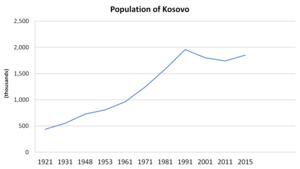Demographics of Kosovo and Metohija

Population of Kosovo (in thousands) from 1921–2015
|
|
| Population |
|
|---|---|
| Growth rate |
|
| Birth rate |
|
| Death rate |
|
| Life expectancy |
|
| • male |
|
| • female |
|
| Fertility rate |
|
| Infant mortality rate |
|
| Net migration rate | -3.72 per 1,000 pop. |
| 0–14 years | 25.8% |
| 15–64 years | 67.2% |
| 65 and over | 7.0% |
| Total | 1.08 male(s)/female |
| Nationality | noun: Kosovar/Kosovan(s) adjective: Kosovar |
| Major ethnic | Albanians (92%) |
| Minor ethnic | Serbs (4%) and others (4%) |
| Official | Albanian and Serbian |
| Spoken |
Albanian (95%) languages of the minorities (5%) |
The Kosovo Agency of Statistics monitors various demographic features of the population of Kosovo, such as population density, ethnicity, education level, health of the populace, economic status, religious affiliations and other aspects of the population. Censuses, normally conducted at ten-year intervals, record the demographic characteristics of the population. According to the first census conducted after the 2008 declaration of independence in 2011, the permanent population of Kosovo had reached 1,739,825, excluding North Kosovo.
Albanians form the majority in Kosovo, with over 92% of the total population; significant minorities include Serbs and others. A 2015 estimate put Kosovo's population at 1,870,981.
The final results of the 2011 census recorded Kosovo excluding North Kosovo as having 1,739,825 inhabitants.ECMI "calls for caution when referring to the 2011 census", due to the boycott by Serb-majority municipalities in North Kosovo and the partial boycott by Serb and Roma in southern Kosovo. The total population number was below most previous estimates. The census enjoyed considerable technical assistance from international agencies and appears to have been endorsed by Eurostat; it was, however, the first full census since 1981, and not one of an uninterrupted series. The results show that there were no people temporarily resident in hotels or refugee camps at the time of the census; that out of 312,711 conventional dwellings, 99,808 (over 30%) were unoccupied; and that three municipalities designed under the Ahtisaari Plan - Klokot, Novo Brdo, and Štrpce to have Serb majorities in fact had ethnic Albanian majorities (although their municipal assemblies have Serb majorities).
...
Wikipedia
